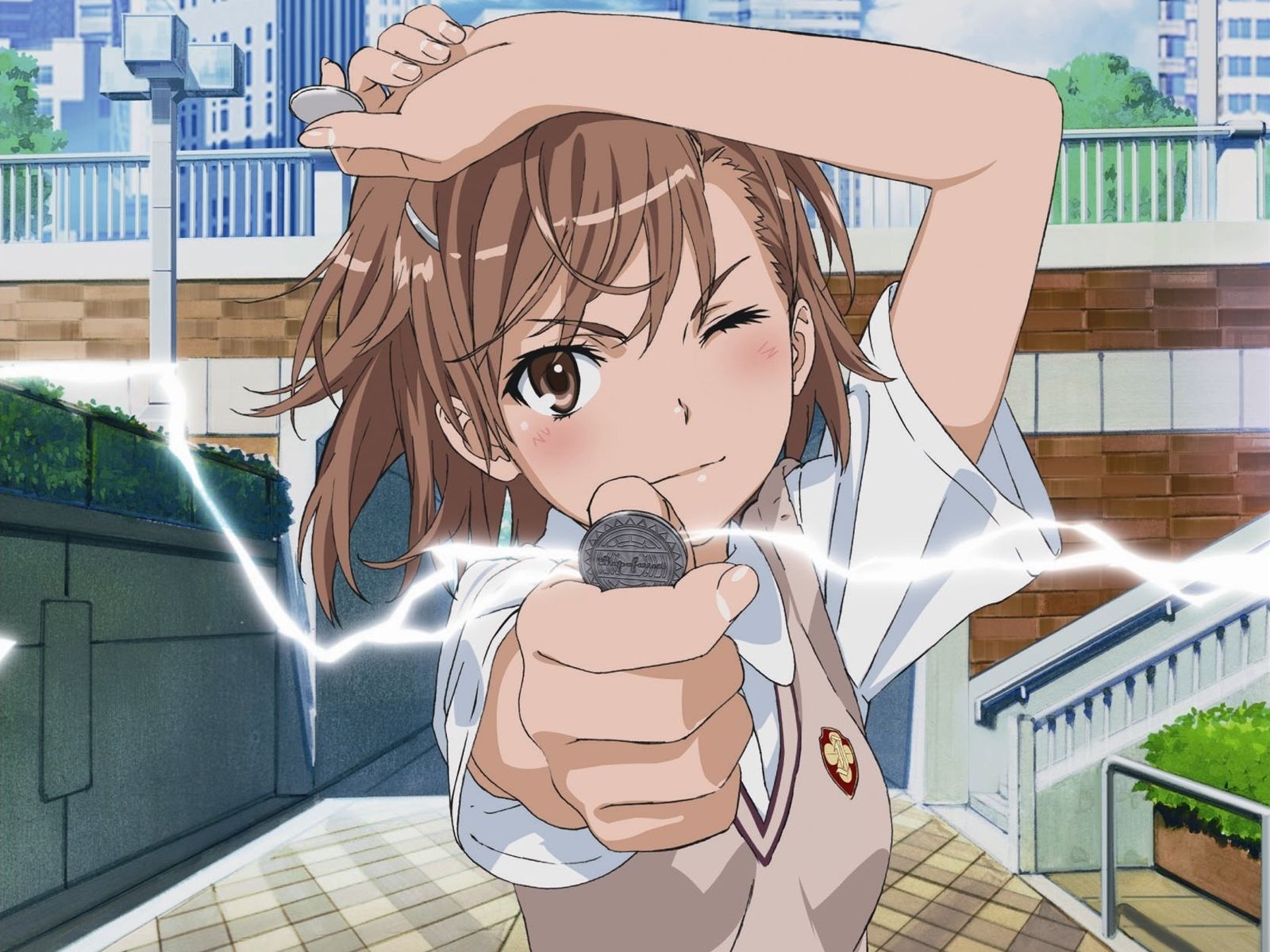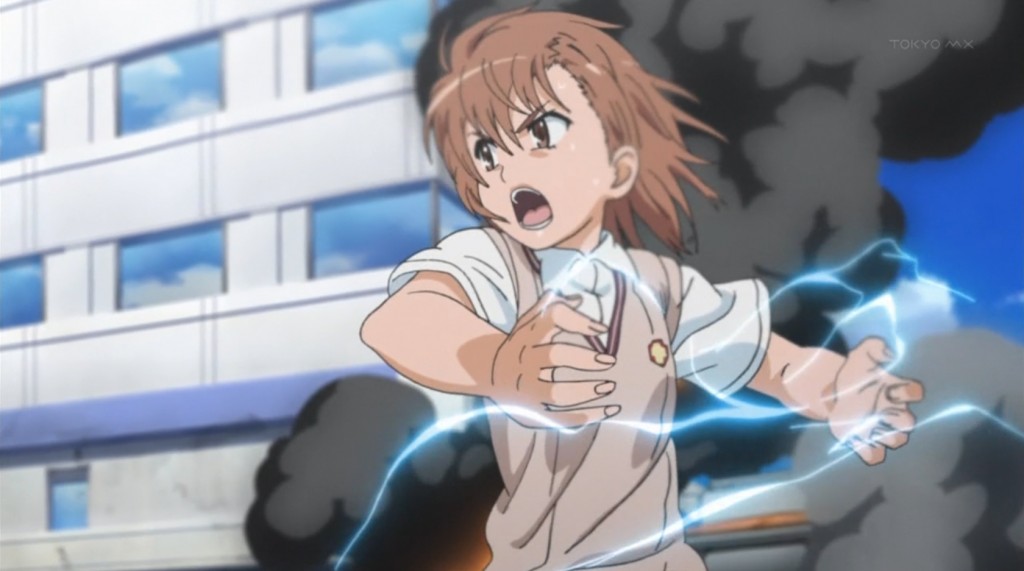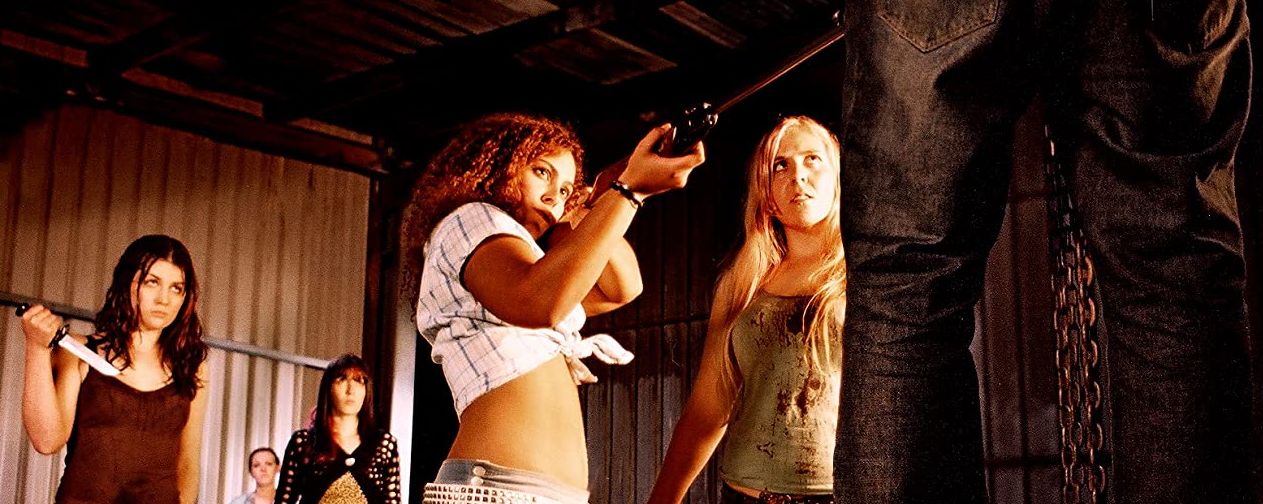 ★★★
★★★
“Beware level 5-espers when they point their fingers at you!”
Have you ever noticed, when you are consciously looking for things that fall into a certain category, you find more and more of them? You may have seen it in action yourself after you discovered the “girls with guns” genre. Compare it to the time before you knew about it, how few movies/series there seemed to be there, and how much you realized were actually available after this site drew your attention to the specific genre. I have started to experience the same thing since I started to look into anime, and in particular the specific target of entries belonging to the GWG genre, that go beyond your usual Miyazaki-Ghibli production.
But then, anime seems like a bottomless pit; I recently saw a video by a German anime fan and publisher, who said there are thousands of anime being produced each year. For the year 2017 he spoke of 3,400 (!). I don’t know if that’s true: but considering, for example, how many Hong Kong martial arts movies I found when I really was looking for this specific kind of entertainment, I wouldn’t be surprised if it was true. Of course, he also admitted most of these anime series are garbage, get ignored and vanish as fast as they appeared. The Japanese manga and anime market is every bit as focused on turning an idea into a highly profitable product (including action figures, OVAs, soundtracks, etc.) as your average Hollywood franchise.
They may perhaps be even more calculated. The business is a highly competitive one, with studios opening and closing every year: they only stay in the business for as long as they produce successful series, and a lot of underpaid animators work free-lance. As enjoyable as this stuff can be, the production background is merciless. It’s maybe better to ignore it, especially as most of these series on DVD are just too expensive (though I never bought bootlegs, but if the Anglo-American territory offers a cheaper alternative, why should you buy over-priced German-dubbed volume boxes?).
But onto the subject of this review. This is a spin-off of another anime series, A Certain Scientific Index, which preceded Railgun. I’m not reviewing the original show, or its other spin-off, A Certain Scientific Accelerator, but would like to stress that while Index is a good show, Railgun is much better. All these series are based on the manga and light novels of author Kazuma Kamachi. He, obviously, is continuously working on his own fictional universe. There are so many volumes of the respective series out there, people on YouTube are making videos on what series to read/watch, and in which order, to get into it without having to consume everything that is on the market. The three seasons of the show I review here have alone already reached 69 episodes.
Index deals with a male character, Kamijou Touma, who has to solve problems of girls and other people, that are either of a magical or a supernatural (read: scientific) nature. Railgun puts a supporting character from Index, middle-school girl Misaka Mikoto, and her female friends to the center of the viewer’s attention. While Railgun might have been created to cater to a female audience, it may have become more popular for a general audience, similarly to how Xena overtook Hercules in popularity. Part of the reason may be Misaka Mikoto’s cuteness, for the Japanese love everything that is “kawaii”.
 Misaka is an esper of the highest degree, level 5. And while she is one of only seven level-5 espers in Academy City, this is not as unusual as it may sound at first. For the whole city is filled with students that Charles Xavier would probably have called “extraordinarily gifted”! They are all learning to develop and use their abilities at school, though for what purpose I still have not found out; is there a job market for those kind of abilities? Still, given their powers it’s a very sensible thing to do, since otherwise the students might easily misuse their powers.
Misaka is an esper of the highest degree, level 5. And while she is one of only seven level-5 espers in Academy City, this is not as unusual as it may sound at first. For the whole city is filled with students that Charles Xavier would probably have called “extraordinarily gifted”! They are all learning to develop and use their abilities at school, though for what purpose I still have not found out; is there a job market for those kind of abilities? Still, given their powers it’s a very sensible thing to do, since otherwise the students might easily misuse their powers.
It’s understandable if this sounds a bit like your typical X-Men animated show from the late 90s. But those shows were primarily concerned with showcasing the abilities of these supernatural beings and adapting the most well-known comic book story-lines. Railgun is a bit different. Heck, it may not even really belong to the same genre as the X-Men, and very often puts its focus elsewhere. It may be the reason this series originally was of minor interest for many. While the girls from time to time show what they are capable of, the main narrative is telling nice little stories about the girls’ everyday life. Getting to know each other, their own little (or bigger) problems and oddities, going out in their spare time and… yeah… Occasionally solving some crimes and blowing things up!
This kind of tale is called “a slice of life story” and is its own genre in Japanese manga and anime. While we have that in the West too, I never noticed and probably would categorize this mainly as “drama”. But then this genre can obviously encompass more, as it is in part a social drama about girl friendships, part sitcom and (here) part superhero story. What to make out of this is, I think, up to individual taste. I can absolutely understand that, for many in the West, this kind of story is unusual; those expecting an ongoing superhero saga will likely be disappointed by this kind of storytelling. I personally found it charming and fresh, even though there certain elements did astonish me. The closest thing to this kind of show in the West might be something like Smallville.
The girl group here consists of the following. Misaka, who is able to control, and more importantly unleash an enormous amount of electricity. Her room partner, Kuroko, who is a teleporter and has a very painful-to-watch crush on Misaka. Uiharu, whose power is somewhat vague, but it is indicated that she can control the temperature of things. And finally, her best friend Saten, who surprisingly has no superpowers at all. Which actually comes in very handy at the end of the story, because sometimes having such a talent can be your Achilles heel.
Other characters include, Konori, a normal teen working for “Judgement”, kind of a social service which Kuroko and Uiharu also join. These teens maintain order on the streets, ranging from helping find a lost bag up to preventing innocent people being harassed or beaten up by outcast rowdies. Then there’s the school director who regularly seems to break Kuroko’s neck (or at least it sounds like it!), when she and Misaka use their powers on school property. The strange Doctor Kiyama who turns out to be the local legend known as “The Undresser”. This means she regularly takes her clothes off without any embarrassment, for minor reasons like it being too hot. No, I’m not making this up, I swear. It’s part of the story.
In the beginning Uiharu and Saten get to know Misaka who, much to the astonishment of Saten, isn’t arrogant at all, as most high-level espers seem to become. Misaka is a cool, sympathetic girl, constantly angered by… the affections of Kuroko, whose feelings for her are definitely more than platonic. It’s kind of shocking sometimes for me, when behavior we would probably label as bordering on sexual assault, is depicted in an animated show, largely targeted towards teen girls. But then this is anime and we all know it operates with different parameters from Western entertainment! Also, the show never takes itself too seriously. Except when it actually does, but more on that later.
Misaka sees through all Kuroko’s attempted manipulations and when Kuroko goes too far, you can expect Misaka to throw her (virtually) out or use her electro-powers on her. The pair remind me in their strange “dog-cat-relationship” of DC’s Harley Quinn and Poison Ivy, with the difference that the Japanese versions are the good gals! It’s just natural that hotheaded tomboy Misaka is the leader of the group. Though she mainly keeps her powers in check, she may from time to time break the rules, such as by duping the public vending machine or when hunting an evil-doer. You know something not so good is coming your way, when she tosses a coin with enormous power in your direction.
While she has a temper on the outside, she is a sweetheart on the inside, caring very much for her friends and the people around her, and is definitely in the process of learning to trust others and to open her heart. Her most beautiful moments are when she is emotionally touched and doesn’t know how to articulate what she feels. It grounds this over-powered character and makes her more human. Indeed this “over-poweredness” was the reason why Kazuma Kamachi originally wanted to make Kuroko the main character, but the publishers saw it differently. Mikoto is not perfect despite all of she is being able to and that makes her so relatable.
 These powers are what gave her in the previous Index show the name of “Railgun”- in her words, “because even objects of a minor size can generate an enormous power when thrown with enough energy in one’s direction”. She also comes across Touma, the main character of Index, who embarrasses her when he tries to rescue her from the company of some teenage boys. Unfortunately for him, she takes his well-meant help as a personal insult, which leads her to constantly challenge him to a fight. Unfortunately for her, his special power is that the talents of others don’t really function when he holds up his hand. Hilarious scenes ensue.
These powers are what gave her in the previous Index show the name of “Railgun”- in her words, “because even objects of a minor size can generate an enormous power when thrown with enough energy in one’s direction”. She also comes across Touma, the main character of Index, who embarrasses her when he tries to rescue her from the company of some teenage boys. Unfortunately for him, she takes his well-meant help as a personal insult, which leads her to constantly challenge him to a fight. Unfortunately for her, his special power is that the talents of others don’t really function when he holds up his hand. Hilarious scenes ensue.
It’s a good show in the GWG anime genre, though in my book no match to highlights such as Black Lagoon, Canaan or Mirai Nikki. If you are in the mood for something a bit different, that shouldn’t be taken too seriously, this might be something for you. It’s sometimes light as a feather, followed by solid SF action and intriguing plots, while still retaining its own certain charm. It may not sound like too much, but having recently watched the dense and sometimes difficult to understand Bakemonogatari, I actually enjoyed this much more.
The series consists of a nice mixture of stand-alone episodes and a very slowly building story-arc. I like that very much, as it gives time to build each of the characters, their relationships to each other and emotional connective moments for us, the audience. This kind of structure also did remind me a bit of the old X Files show with its single episodes, in contrast to today’s series, which tend to have a constantly developing story arc. You miss a few episodes and you’ve got problems catching up, and trying to understand what’s happening again.
That’s not the case with Railgun. The series initially takes its time, with the girls and their everyday life the focus of attention. Then, to my surprise, it moved to a bigger story with unethical experiments performed on helpless esper kids, and dark forces lurking in the background. It’s almost shocking, since the place we have been shown here mostly seemed sunny, funny and enjoyable. The biggest problems the girls ever faced, was how to deal with personal little insecurities. But where there’s light, there must be shadow, too! Local urban legends of a “level-upper”, a device said to improve or increase one’s esper abilities, make the rounds and while investigating these seem a harmless leisure activity for the girls, the outcome is much bigger than anyone could have foreseen in the beginning.
After a big climax it looks to go back to square one, and we return to small “what did XYZ today” stories. But then a new girl appears and so-called “poltergeist activities” happen around her, leading to another, much bigger challenge which also includes a twist. Not everyone you think must be put behind bars is evil; not everyone you trust is trustworthy; and sometimes the one with the least powers can be the savior of the day.
What I especially liked was that each of the girls is their own character and acts differently. They are not just bland copies of each other with only differing abilities. While I don’t think many people will ever get to know this series if they are not deep into anime, I especially enjoyed the way it structured its story. We in the West may have had our Kim Possible, the Japanese post-Sailor Moon have this. I liked it well enough to invest time and money in the second season, A Certain Scientific Railgun – S, which will also be reviewed here.
Dir: Tatsuyuki Nagai
Star (voice): Rina Satō, Satomi Arai, Aki Toyosaki, Kanae Itō





 Well, this is certainly the first film I’ve reviewed here which drops both into the “women in prison”
Well, this is certainly the first film I’ve reviewed here which drops both into the “women in prison”  At 85 minutes, this might have been fine. For it’s a fairly simple tale, of three women who decide to escape their financial woes by drugging and robbing married men, banking on their victims not being willing to involve the authorities. While this initially works as planned, inevitably, they end up targeting the wrong guy, a minion of feared drug dealer Grey (Anderson). How evil is he? Grey appears to have an employee whose full-time job is to fan him. That’s some Evil Overlord style, right there. Grey doesn’t just want his stolen money back, he wants the trio to continue their activities – for his benefit. And that isn’t the only problem which the trio face, with Tony, the estranged other half of Dawn (Tares), unhappy at her having escaped their abusive relationship.
At 85 minutes, this might have been fine. For it’s a fairly simple tale, of three women who decide to escape their financial woes by drugging and robbing married men, banking on their victims not being willing to involve the authorities. While this initially works as planned, inevitably, they end up targeting the wrong guy, a minion of feared drug dealer Grey (Anderson). How evil is he? Grey appears to have an employee whose full-time job is to fan him. That’s some Evil Overlord style, right there. Grey doesn’t just want his stolen money back, he wants the trio to continue their activities – for his benefit. And that isn’t the only problem which the trio face, with Tony, the estranged other half of Dawn (Tares), unhappy at her having escaped their abusive relationship.
 ★★★½
★★★½ Four women run a charitable agency in Texas, helping single mothers track down and obtain child support payments from deadbeat dads. However, they don’t limit themselves to the simple serving of legal papers. The women adopt a more… hands-on approach, shall we say, first luring their targets in with the promise of sex, then threatening them at gunpoint, to make sure they pay up. For obvious reasons, the cops soon take interest in this string of unusual armed robberies. Meanwhile, the city’s white mayor, is dealing with a domestic crisis of her own, thanks to her daughter having had a child by (gasp!) a black man.
Four women run a charitable agency in Texas, helping single mothers track down and obtain child support payments from deadbeat dads. However, they don’t limit themselves to the simple serving of legal papers. The women adopt a more… hands-on approach, shall we say, first luring their targets in with the promise of sex, then threatening them at gunpoint, to make sure they pay up. For obvious reasons, the cops soon take interest in this string of unusual armed robberies. Meanwhile, the city’s white mayor, is dealing with a domestic crisis of her own, thanks to her daughter having had a child by (gasp!) a black man. Even if the film doesn’t quite live up to the title and poster, it turned out to be better than I expected… from the title and poster, to be honest. It has been my experience that, the more lurid the advertising, the more disappointed I’m likely to be. Films like this often don’t just fail to deliver on what they promise, they also struggle with basic aspects of film-making, like plot and characterization, providing a double-whammy of failure. While the former is true here (no-one, at any point, is
Even if the film doesn’t quite live up to the title and poster, it turned out to be better than I expected… from the title and poster, to be honest. It has been my experience that, the more lurid the advertising, the more disappointed I’m likely to be. Films like this often don’t just fail to deliver on what they promise, they also struggle with basic aspects of film-making, like plot and characterization, providing a double-whammy of failure. While the former is true here (no-one, at any point, is  There’s a fascinating idea at the core here. Namely, that vampires were created by God, in order to mitigate mankind’s sin by preying on the most evil examples of humanity. They’re effectively angelic enforcers. The potential in this is great. The execution, however… Well, it largely comes down to two such vampire/angels sitting around a gas station for the majority of the running time. This isn’t the only aspect which is poorly considered. It starts in 1969, when lesbian couple Brooke (Lahiri) and Rhea (Monk) are at a New Year’s party. Brooke kills a rapist, stabbing him (literally) 87 times, and the pair then flee. In the desert, they are visited by God (model Angela Lindvall), who makes Rhea into one of her enforcers.
There’s a fascinating idea at the core here. Namely, that vampires were created by God, in order to mitigate mankind’s sin by preying on the most evil examples of humanity. They’re effectively angelic enforcers. The potential in this is great. The execution, however… Well, it largely comes down to two such vampire/angels sitting around a gas station for the majority of the running time. This isn’t the only aspect which is poorly considered. It starts in 1969, when lesbian couple Brooke (Lahiri) and Rhea (Monk) are at a New Year’s party. Brooke kills a rapist, stabbing him (literally) 87 times, and the pair then flee. In the desert, they are visited by God (model Angela Lindvall), who makes Rhea into one of her enforcers. Often forgotten in the critical acclaim for the
Often forgotten in the critical acclaim for the  Playing somewhat like a more brutal version of Fatal Attraction, this sees Ray (Norlén) help out the girl next door, Tara (Dickinson) with some heavy suitcases she’s trying to move into her car. From this eventually stems a one-night stand between the pair, made all the more unfortunate by Ray’s girlfriend, Maddy (Wehrle) being stranded by the side of the road with a flat, while the pair do the dirty deed. Ray then discovers Tara’s darker side: and when I say “darker side”, I mean she makes Alex Forrest of Fatal Attraction look like a bunny-boiling beginner. With the aid of a condom from their dangerous liaison, she frames him for the rape/murder of his boss, forcing him to help her get rid of the body. And Tara is only getting warmed up. Wait until she gets her hands on Maddy…
Playing somewhat like a more brutal version of Fatal Attraction, this sees Ray (Norlén) help out the girl next door, Tara (Dickinson) with some heavy suitcases she’s trying to move into her car. From this eventually stems a one-night stand between the pair, made all the more unfortunate by Ray’s girlfriend, Maddy (Wehrle) being stranded by the side of the road with a flat, while the pair do the dirty deed. Ray then discovers Tara’s darker side: and when I say “darker side”, I mean she makes Alex Forrest of Fatal Attraction look like a bunny-boiling beginner. With the aid of a condom from their dangerous liaison, she frames him for the rape/murder of his boss, forcing him to help her get rid of the body. And Tara is only getting warmed up. Wait until she gets her hands on Maddy…